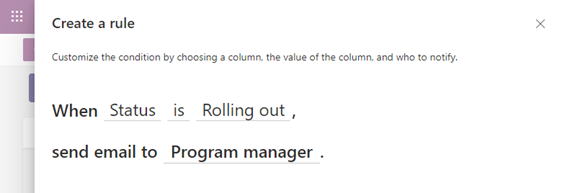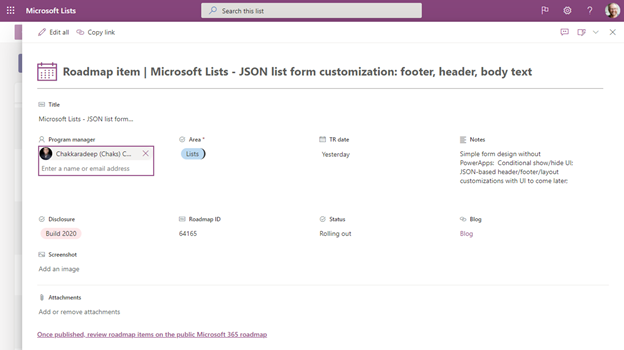Going beyond the out-of-box experience doesn’t always require coding or separate tools. With Microsoft Lists, you can further customize forms and notifications with a few clicks, or a copy/paste of JSON code. Both capabilities are now rolling out into Microsoft 365.
Watch @Chakkaradeep (Chaks) Chinnakonda Chandran, senior program manager on the Microsoft Lists engineering team, as he provides a 10-minute demo of what you can do with Lists rules and forms customization:
Writing rules as easy as point-and-clicking structured sentences [Roadmap ID: 64163 – rolling out]
Create simple if/then rules, based on changes to list information, to set reminders and send notifications. Users with edit permissions on the list can create and manage rules. Users with read-only permissions can’t create or manage rules. Once the feature is available to your users, they’ll be able to create a rule by selecting Automate and then Create a rule in the list command bar near the top of the page.
Click the Automate drop-down menu, and then select “Create a rule” to begin creating rules for your list.
Create your rule(s) is like writing a sentence. Select each of the underlined portions of the rule statement to customize the condition by choosing a column, the value of the column, and who to notify.
JSON list form customization: footer, header, body text [Roadmap ID: 63519 – rolling out]
You can configure the list form in a list or library with a custom header, footer, and the form body with one or more sections with fields in each of those sections. The form configuration does not change the data in the list item or file; it only changes how the form is displayed to users who browse the list or library. Anyone who can create and manage views in a list can use form configuration to configure the form with header, footer, and body with sections.
A Microsoft Lists form configured with a custom header (the calendar icon plus text incorporating Title field), a custom layout (expanded left-to-right to show more), and a custom footer (here adding a link to a related site). Small meta-note: this is the list item from our internal roadmap list to track this exact roadmap feature and Chakkaradeep is our lead PM.
Learn More:
Edit form > Configure layout. To configure a form, you will use JSON formatters that you are already familiar with when formatting a column or a view in a list or library. Form configuration allows for certain predefined elements and attributes to build the custom header, footer, and body with one or more sections.
Learn more (docs.microsoft.com) including sample JSON for header, footer, and body sections for your forms. Plus, Microsoft senior partner technical architect, April Dunnam, recently published a ‘how to’ blog + video + samples, "Customize SharePoint Forms with JSON" (April’s 'ListFormatting' repository in GitHub).
To learn more about Lists throughout the year, please visit our Lists help and learning site, plus our updated Microsoft Lists resource center (adoption materials, blogs, demos, videos, podcasts, and more).
Track what matters most. Make a list, and let it flow.
Source: Paper.li
The Tech Platform





Comments